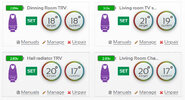I can only talk about my own experience at my mothers old house. I was using electronic heads which reported current and target temperatures to the PC. I realised the temperatures were over shooting, set to 20ºC I was seeing the room heat to 22ºC, I realised what was happening was the radiator would get stinking hot, and so was still heating the room even when the TRV had closed, when the TRV's exercise at 12 midday every Saturday it takes around 3.5 minutes to do whole cycle, and it takes time for heat to reach the TRV to start with.
So the report

makes it easy, if any radiator in winter has the current above target I closed the lock shield a little, after some time I had got it so every room except for living room was spot on, living room was a problem as it had bay windows, so morning sun could cause the room temperature to raise above setting even when central heating not running, nothing I could really do about that, except did not adjust on sunny days.
The thing I noted after it was adjusted is the boiler would modulate better, (Worcester Bosch rather old) and the radiators were not longer stinking hot, but just warm enough to maintain the room temperature. And there seemed very little hysteresis in the room temperatures.
I had observed another problem with my sons house, he had not set any TRV's, and the house heated up a room at a time, so easiest room for water to flow to heated first, once house was warm it worked A1, but let the house cool down, then try to reheat, it would take an age, reason was simple, if hot water returns to boiler the boiler modulates, so he had a 28 kW boiler but it was only running at around 6 kW as the returning hot water was turning down the boiler.
So looking at those two homes with modulating boilers the lock shield setting was important. However in this house the oil fired boiler does not modulate, it can only cycle on/off, and trying the same method as used with mothers house did not seem to work very well, also this house is micro bore piping, with this house having the lock shield valves not wide open, but not throttled back like other two homes seems to work better.
I now have 9 electronic TRV heads, non connected to the wall thermostat, unfortunately Nest Gen 3 does not support that, so only radiator where the lock shield valve setting seems important is the hall, if hall heats up too fast it turns off boiler prematurely. But other than hall it does not seem to matter how the lock shields are set.
So from these three homes, I would say with modulating boilers the lock shield valve setting is very important, but not so important if the boiler does not modulate, my oil boiler only monitors output water temperature, it does not monitor the return water temperature.


